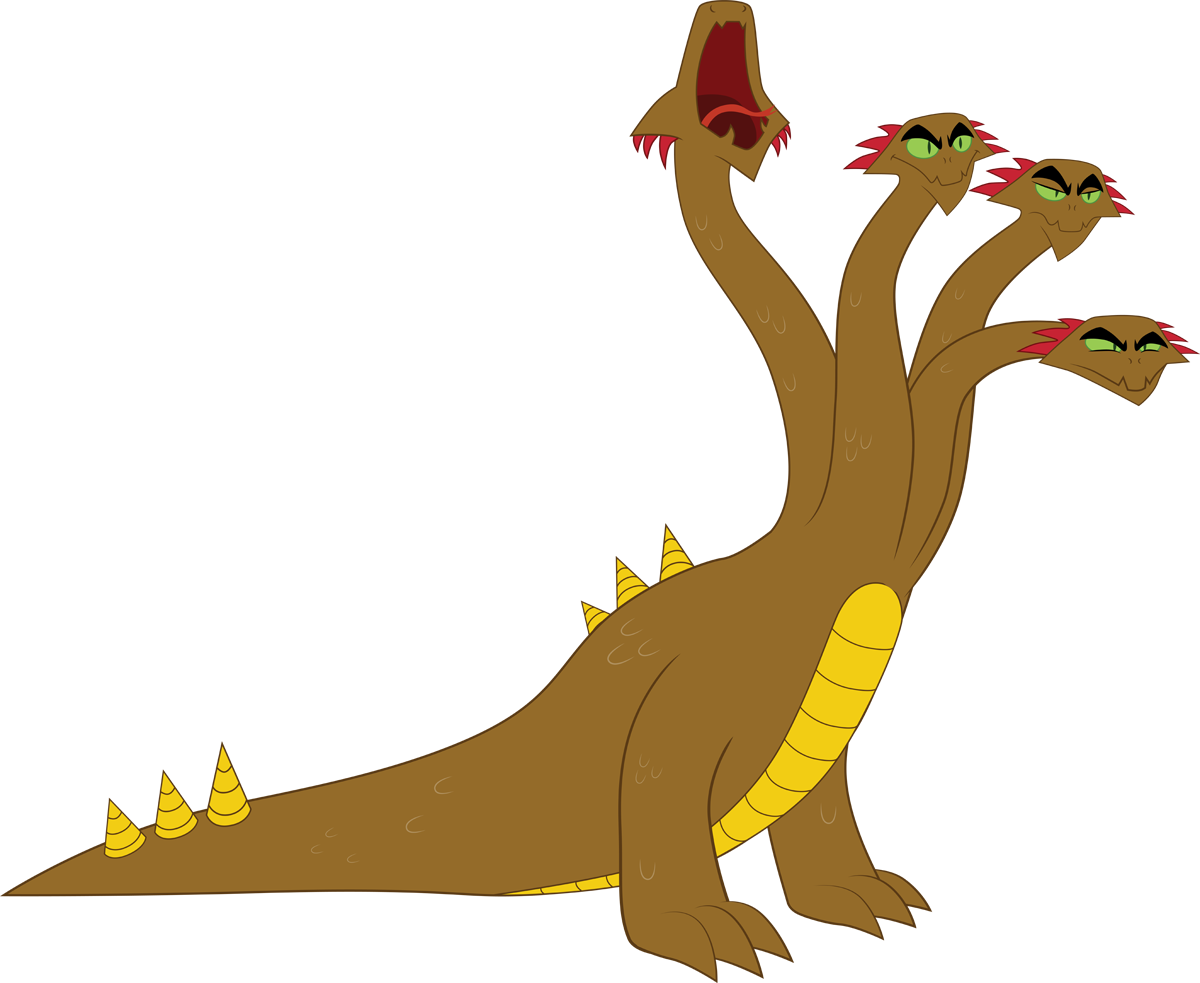The Equestrian Bestiary: An A-Z
Chapter 14: Hydra
Previous Chapter Next ChapterHydra
MIGHT - 3/5 to 4/5 (Depending on nature of the creatures heads)
RARITY- 4/5
By Peregrine Caged
Hydras are incredibly dangerous creatures, intelligent and vicious, whose immense size is only matched by their thankful scarcity. They resemble a reptilian beast with anywhere between three and seven heads, a tail, two legs, and no arms. They stand at a towering 40’ on average--specimens as tall as 50’ have been verified in the past. They average anywhere from 8000 to up to 12000 pounds. In general, males and females are roughly the same size - although the female gender of the hydra has brightly coloured frills, while the males is a muddy crimson.
Hydra colourings are always dull browns and greens, which allow them to hide amongst the murky and plant-filled waters they call home. Their scales are about the size of a pony’s head and can resist extreme slashing and bludgeoning forces, though they are susceptible to powerful piercing blows. Hydras possess a tail that is often as long as their necks--most typically, a hydras length is divided into thirds between the tail, body, and necks. The occasional hydra has been seen without a tail--research on whether this is a different species is ongoing.
Hydras possess terribly sharp teeth, with a jaw strength to match. They can easily pull up and crush trees or chew stone in chasing after prey. However, their heads are relatively small compared to the rest of their body and as such are a weak point for the creature. Often one good blow to a head will dissuade a hydra from continuing pursuit, as they are so unused to feeling pain of any kind.
Hydras live to around 500 years of age. While many details are uncertain, it is estimated they come of age at 80 to 120 years of age and proceed to mate once every thirty years afterwards. Mating season causes hydras to leave their territories in search of a mate. Mating pairs split shortly afterwards to return to their own territories, where females lay one to three eggs. She then incubates them until they hatch and raises the young for about twenty years before chasing them away or eating them if they are too slow.
Hydras are mainly dangerous simply through their size, strength, and ferocity. They possess no innate magic or special abilities. However, because of their multiple heads, some hydras can be incredibly cunning and intelligent. On the flip side, a hydra burdened with a less intelligent (or even outright idiotic) head is far easier to outwit and outmaneuver.
An average, healthy earth pony can typically outrun hydras for short distances--however, the hydras long stride and greater endurance will eventually allow them to catch up. Hydras are not capable of the quick, sharp turns an earth pony can make, and so it is advised to run in a zigzag pattern if caught being chased. Hydras have no flight capability and therefore can easily be flown away from--though a pegasus must take care to reach a proper height, as hydras have a decent reach between their height and the length of their necks. Only the most powerful of unicorns could ever hope to affect the hydra magically, simply through their sheer size.
All hydras are vicious predators, extremely deadly when hunting but otherwise relatively quiet when resting. However, any hydra disturbed from its rest will not stop until it has devoured intruders. Beyond that, hydras vary in behavior depending upon individual heads. Each head seems to possess its own degree of intelligence and therefore personality. Some hydra heads have been observed to be incredibly violent, striking out at other heads when riled. Some have been found lazy or easily distracted, often ruining hunts for the beast. It is fortunate that so many hydras seem to possess at least one head that acts as a handicap, otherwise they would be truly nightmarish beasts of terror. Records tell of one such hydra, possessed of seven incredibly violent, wickedly intelligent heads, that rampaged amongst pony settlements and towns without provocation or warning before being killed.

As a species, they are individualistic by nature. It has been suggested that each head acts as another creature in regards to social needs and so they split by individual bodies to avoid food competition. Often, hundreds of acres of swampland will represent the territory of a single hydra. Because of their relative scarcity, hydra infighting has never been witnessed (apart from head infighting), though it is unsure of what would happen were territories to overlap.
Hydras live exclusively in large and undisturbed swamps and marshes throughout Equestria. As reptiles, they do not handle cold climates well and so they live only in a small climate band of territories. Amazingly enough, despite their large size, hydras will often spend most of their time completely submerged in the muck and mud of their swampland home. The record for a hydra holding its breath is currently 39 hours. It is unknown if hyrdras simply choose one spot to nest or if they continually move about their chosen territory.
Hydras subsist largely on fish, amphibians, reptiles, and birds found in swamplands--but they will eat any meat they can catch, including pony. Due to their size, they simply swallow anything they catch whole--bones, scales, fur, and other such things pose no problems for their digestive tracts. Food eaten by any head combines into one unified digestive system and therefore sustains the entire creature. It is not uncommon for a hydra’s heads to develop a hierarchy, pushing one or two heads to do most of the hunting. Thankfully, in regards to habitat sustainability, hydras eat one large meal (about one third of their body weight) every three months--while they will eat anything that disturbs them in the meantime, it is unnecessary for them to seek out more food.

